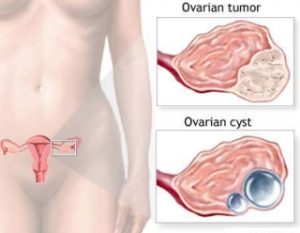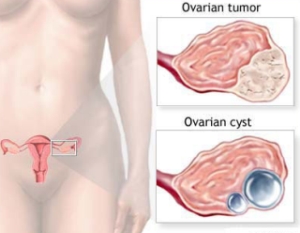All too often, there is a failure to understand the difference between ovarian cancer and ovarian cysts. This lack of understanding has led to a great deal of anguish and sleepless nights for women who were not aware of what distinguishes a cyst in the ovaries from a cancerous growth. Here is what you need to know in order to know what is actually going on when either of these conditions is mentioned.
One major difference has to do with the composition of the growth itself. If you have an ovarian cyst, it will be a sac that is filled with liquid, and contained within a thin wall. By contrast, an tumor that has the chance to become ovarian cancer will be much more solid, with a feel that is almost like that of a muscle.
The development of outward signs and symptoms is another point of difference between ovarian cancer and ovarian cysts. Cysts do not necessarily create any symptoms at all.
You may discover that you have a cyst only after your doctor identifies the presence of a cyst while checking you reproductive for signs of some other ailment. However, it is very rare for ovarian cancer to not manifest at least a few symptoms. You are much more likely to exhibit bloating or weight gain with a cancer, and may experience a greater degree of abdominal pain with the cancer than you ever would with a cyst.

It is important to remember that while a cyst is almost always benign, a cancerous tumor is malignant. You will often find that it is possible to live with a benign cyst for an extended period of time with relatively little danger to life; that is not the case with the cancer.
Doctors may choose to monitor a cyst while trying different approaches to help ease the symptoms caused by the growth. But if there is suspicion that the growth is really a cancer, your doctor will want to schedule surgeryimmediately, before the cancer has a chance to spread to your other ovary or possibly to other organs in your body.
Another important difference between ovarian cancer and ovarian cysts has to do with the way the mass grows over time. With a cyst, it is not unusual for the mass to appear, grow for a short period of time, then begin to shrink and eventually disappear. With ovarian cancer, that does not happen. Instead, the mass simply becomes larger, gradually consuming more of the ovary until the organ can no longer function.
While there is more than one difference between ovarian cancer and ovarian cysts, your best bet is to see your doctor for regular checkups. Should you experience any pain in the abdomen, lower back, thighs, or pelvis in between checkups, do not hesitate to schedule an appointment immediately.
It may be that you have a cyst that will be around a short time, then go away. But if the growth does turn out to be ovarian cancer, the sooner you begin treatment the better chances you have of overcoming the disease.
